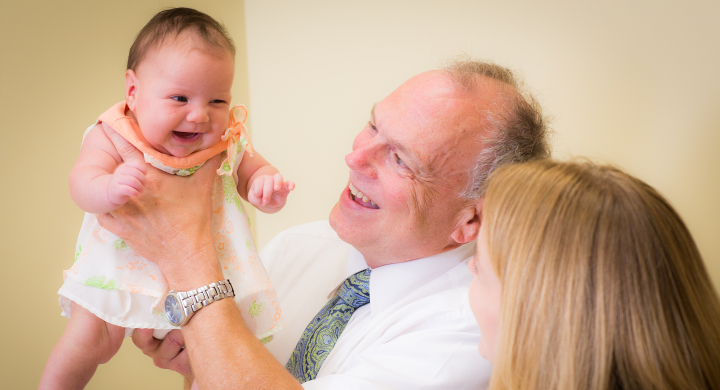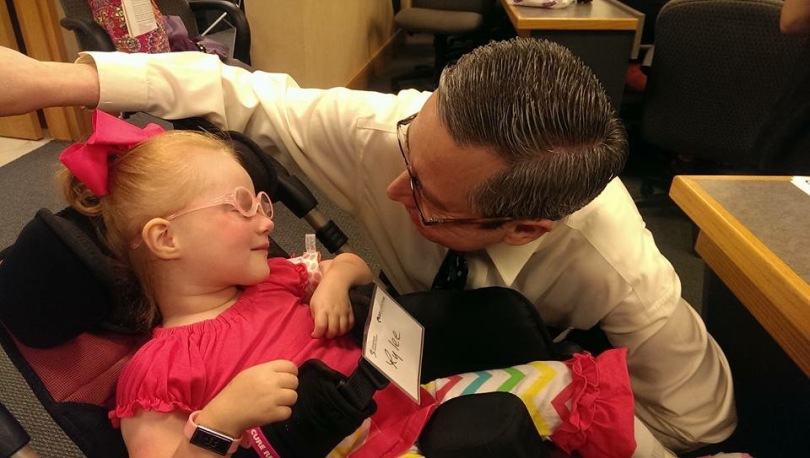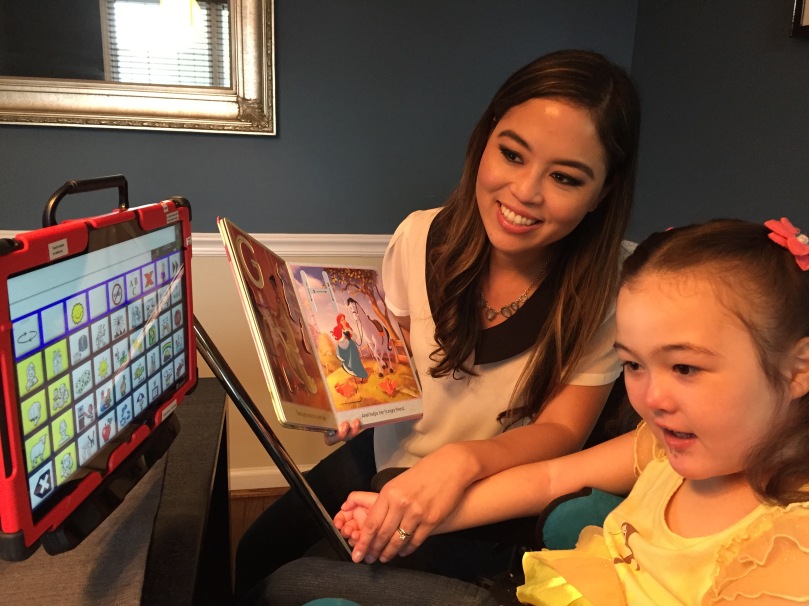One family’s story of an ultra-rare diagnosis, advocacy, and hope
The Diagnostic Odyssey…
Our 10-year-old son, Connor, has Snyder-Robinson syndrome . “What in the world is that?” you may ask. We asked the same question when we first heard about it.

Connor has been through a great deal in his decade of life – starting at 2 weeks of age when he was hospitalized with failure to thrive. He underwent occupational therapy and wore a splint due to camptodactyly (bent fingers). At 3 months of age, he was still not able to hold his head up or to roll and his head became misshapen (plagiocephaly) due to hypotonia (poor muscle tone) and torticollis. He started PT at four months and wore a helmet for skull shaping until his first birthday.
Around 6 months, Connor was clearly not meeting milestones. Lifting his head up while on his stomach was impossible. He would not bear weight on his legs. He hadn’t rolled over and could not sit up.
By the time he was a year old, his pediatrician referred him to a neurologist. That visit started the seemingly endless series of tests to determine the reason for his low muscle tone (hypotonia) and global developmental delays.
When he was almost 2, he had his first seizures.
With intensive therapy, Connor began to talk at 3 years of age, and eventually was able to take his first steps at 4 years of age. He still requires weekly therapy to maintain his ability to walk, to help his speech and to perform activities of daily living.
We spent countless hours researching Connor’s medical issues to try to get a clue – any clue – about what may be happening with our son.
Connor was examined and tested by at least eight geneticists from four top-notch institutions over the course of our diagnostic journey. Most geneticists agreed that he must have a very rare genetic syndrome, but diagnosing it was not possible.
Finally, when he was 5 years old, his geneticist told us about a new test called whole exome sequencing or WES. WES examines the coding regions of all of the genes, looking for a mutation wherever it may be. Maybe this would finally be what we had been hoping for.
The week before Connor’s WES test results came back, we had agreed that we would stop searching for a diagnosis for a couple years if the WES test did not provide an answer. The roller coaster of emotion had proven too much, and we were ready to take a break.
The diagnostic journey had been exhausting, filled with highs and lows. The highs were a result of finding out that he did not have a whichever condition he was being tested for at the moment. The lows stemmed from the utter disappointment of not getting an answer after every test result came back. The lows were also caused by never knowing if we were doing enough. Were we taking him to the right doctors or institutions? Were we asking the right questions?
Shortly before his test results came back, Connor fell and broke his arm, both bones just below his elbow, in half. It wasn’t his first, he had a skull fracture at age 2, and foot fractures at 3 and 4. The ER doctors who treated him searched our faces and found true anguish, or they would have called child protective services. A break like that normally didn’t happen from tripping and falling, as we had claimed. We did not know he had severe osteoporosis. A week later we found out that his bones are as fragile as those of a hundred-year-old woman.
Four months after the WES test was ordered, the test results came back and showed that he had a mutation in the SMS gene which causes Snyder-Robinson Syndrome.
The end of the diagnostic odyssey. The beginning of hope…
To us, not knowing what your child suffers from is more painful than finding out that he has an ultra-rare genetic syndrome for which there is no cure or treatment. Connor was the 21st person to be diagnosed with SRS in the world. We were the 3rd family in the United States. His diagnosis has changed our lives and taken us in a completely different direction, as a family and as individuals. We now had something to focus on to be able to help our son overcome some of his many challenges.
It had a name, and it could be researched. That, in and of itself, seemed like a miracle.
Once we knew Connor had SRS, we immediately learned that Dr. Charles Schwartz and Dr. Roger Stevenson at the Greenwood Genetic Center were the leading SRS experts in the world. I remember the day we reached Dr. Schwartz like it was yesterday. We spoke to him and soon planned a trip to Greenwood, SC to take Connor for evaluation and to meet the first family to be diagnosed with SRS. The day we met the other family and our sons interacted for the first time was incredible!
Within a year of Connor’s diagnosis, we, along with the parents of five other boys diagnosed with SRS, formed the Snyder-Robinson Foundation (SRF). Our mission was to advance medical and scientific research of SRS. Three years later, the SRF has helped to fund four SRS research grants and a pre-doctoral fellowship, and we’ve launched a Natural History Study. The SRF also was able to, through its website and social media, bring people with SRS together from all over the world. There are now approximately 50 people diagnosed with SRS in over 16 countries.
Our work with the SRF provides a vehicle by which we can dare to hope for a treatment or cure for SRS. The SRF is the only patient advocacy organization for SRS, and within a short amount of time, it has accomplished quite a bit. We are very fortunate that the parents and family members who serve on the Board of Directors of the SRF are extremely dedicated and talented individuals. We are proud of the work that we do, we are happy to be a resource for newly diagnosed families, and we are extremely hopeful that one day there will be a treatment that will help everyone diagnosed with SRS.
What SRS means to our family
SRS impacts us as a family in many ways. First, we now spend a lot of time working on the Foundation, going to conferences, fundraising for SRS research and reaching out to newly diagnosed individuals.
On a more personal level, our family dynamic is very different than most families. One of us is constantly caring for a child with unique medical needs, which can be daunting at times.
We do manage to travel sometimes, though our experiences are limited to what Connor can also do and what he can tolerate. Connor’s needs have to come first in almost every situation. This can take an emotional toll on a family, trying to maintain parity among siblings can be difficult.
We are also in a constant state of vigilance, trying to maintain Connor’s safety in different settings- at school, with caretakers, while traveling and in our home. He requires almost constant supervision and needs assistance with all activities of daily living – bathing, dressing, toileting, eating, etc. When he is ill, this is only heightened and can be frightening because there is so much that is unknown about SRS.
Despite these limitations, we try our best to provide as normal a life for all of our children as we can. We do what most parents do – we love our children unconditionally and try to provide for their needs while keeping them healthy and happy.
Moving Forward Towards a Cure
In December of 2017, the Greenwood Genetic Center tried something new. They gathered brilliant scientists, doctors and researchers together for a day and a half to brainstorm and collaborate. Such an event is unprecedented in the rare disease world, to my knowledge. The workshop was followed up with the white paper detailing action steps toward a treatment or cure.
When your child’s rare disease is 1:150,000,000, it is truly astounding that this event came together with such promising results.
We are so grateful to Drs. Charles Schwartz and Roger Stevenson who have gone above and beyond expectations for championing SRS throughout the years. After we received Connor’s diagnosis, our visit with them at GGC felt as if it were a homecoming of sorts. They had arranged for us to meet the other family with SRS and to spend time with them at a pool to get to know one another. This was a tremendous experience, knowing we were not alone in the world – that our son was in great company.
Ever since that meeting, Charles and Roger have persevered in their SRS research and connecting with families worldwide. We met them a year later when they were on their way to visit a newly diagnosed family far away from GGC.
Their dedication is almost as rare as SRS, in my opinion.

If your child is diagnosed with an ultra-rare genetic disorder, you could not be more fortunate than to have experts like Drs. Schwartz and Stevenson working on the disease research. We thank them profusely for their past work and their current ground-breaking work, and are so very hopeful to see where their collaborative projects with the others involved in the workshop will lead.
Michael Raymond and Katia Luedtke are Connor’s parents. Michael serves as the Executive Director of SRF and Katia is the Legal Counsel and Secretary of the SRF.
































